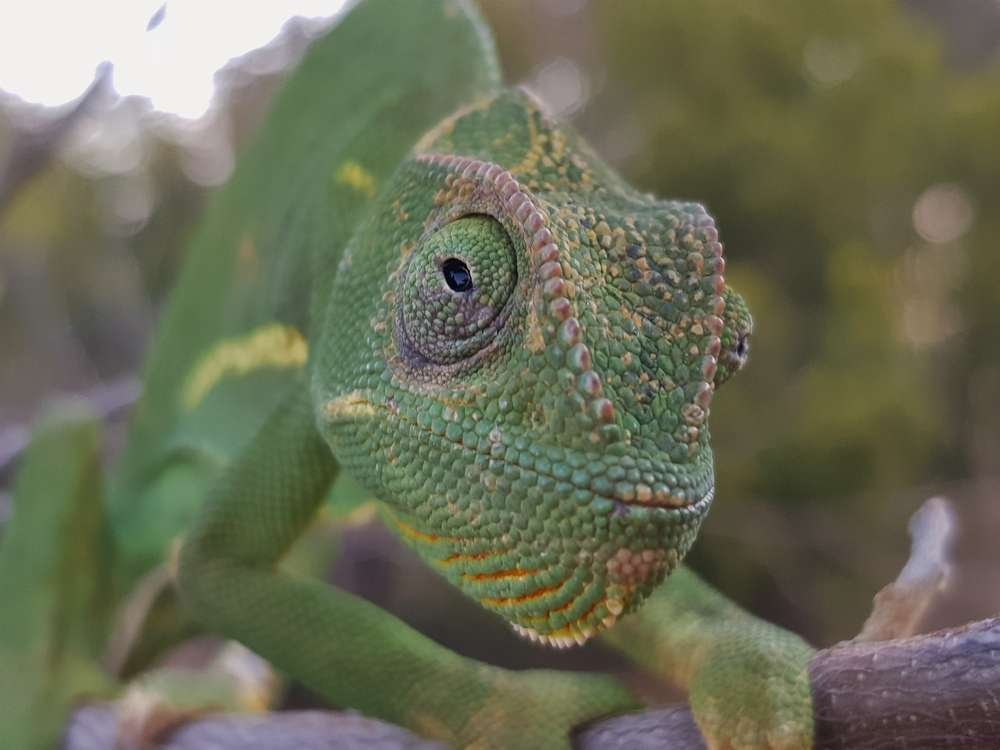Flap-necked Chameleon
( Jackson's chameleon )
- Chamaeleo dilepis
- IUCN Status: Least Concern
- Threat: harmless
- Venom/Toxin: none
- Trend: uncomfirmed

- Phylum: Chordata
- Class: Reptilia
- Order: Squamata
- Suborder: Iguania
- Family: Chamaeleonidae
- Genus: Chamaeleo
Share:
General Information
The Flat necked chameleon is one of the most common chameleon species found in Zambia. It gets its obvious name from a flap like crook shape on its neck.
Fun Facts!
The flap-necked chameleon is one of the largest chameleons in the world. The flap-necked chameleon is known for its distinctive flap of skin on its neck. This flap is used for communication, display, and thermoregulation. Chameleons can move each eye independently. Flat necked chameleon is the third most traded chameleon species. It is highly on demand in the pet trade world. A common misconception is that Chameleons change colour to blend in with their environment when infact they do so to mirror their stress levels. Different patterns represent different health and stress levels.
Description
The flap-necked chameleon is a large chameleon, with males growing up to 30.5 cm in total length and females growing up to 22.9 cm in total length. The basic coloration of the creature ranges through various shades of green, yellow, and brown. There is usually a pale stripe on the lower flanks and one to three pale patches higher on the flanks.
- Length: up to 35 cm
Ecology and Behaviour
The flap-necked chameleon is solitary animal. It only comes together with other chameleons to mate.
The Flat necked chameleon will normally make hissing noises when it feels threatened and it can spit out saliva as a way to deter predators.
The flap-necked chameleon is a carnivore. Its diet consists mainly of insects, but it will also eat small lizards, birds, and mammals.
The flap-necked chameleon is an ambush predator. It uses its long tongue to catch its prey, which it can do in as little as 1/60th of a second!
Diet
The Flat necked chameleon is a carnivore that eats a variety of invertebrates, although large individuals may take geckos and other chameleons. The species is itself commonly preyed on by snakes such as the boomslang and the twig snake.
Reproduction
The adult female flap-necked chameleon lays 10-40 eggs in a hole dug in soil. The eggs take 10–12 months to hatch.
Conservation
It is categorized by the International Union for Conservation of Nature (IUCN) as a, ” Least Concern “
Distribution and Habitat
The Flat necked chameleon inhabits coastal forest, moist or dry savannah, woodland and bushy grasslands, and may also venture into rural and suburban areas. It has a very wide distribution, occurring throughout much of sub-Saharan Africa from as far north as Ethiopia and Somalia to a western extreme of Cameroon, and as far south as northern South Africa.
Interaction with humans
The Flat necked chameleon is in heavy demand for the international pet trade, being the third most highly traded chameleon species. Culturally, the chameleon is one of Zambian’s most feared and misunderstood reptiles. They are considered to be bad omens, especially if you see one crossing the road. They are also locally thought to be poisonous and if you are bitten by one you will then turn into different colours (They are not poisonous, nor their spit and you won’t change colours )
No donation to this project yet.
| M | T | W | T | F | S | S |
|---|---|---|---|---|---|---|
| 1 | 2 | 3 | 4 | 5 | 6 | 7 |
| 8 | 9 | 10 | 11 | 12 | 13 | 14 |
| 15 | 16 | 17 | 18 | 19 | 20 | 21 |
| 22 | 23 | 24 | 25 | 26 | 27 | 28 |
| 29 | 30 | 31 | ||||


